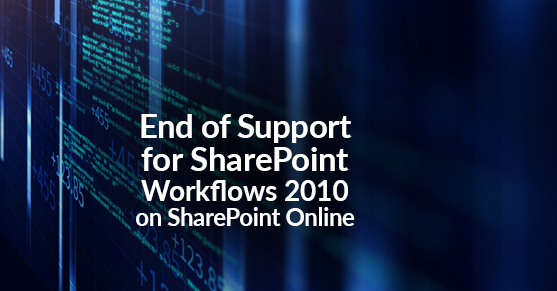It feels like we have to deal with the compounding disruption of innovation on a yearly basis as software companies evaluate their product line, advancing some business solutions while retiring others. As with every other software vendor, the Microsoft 365 product line continues to expand and progress through modern demand, and for SharePoint Online 2010 Workflows, the time has come to put support to rest.
As of August 1, 2020, SharePoint 2010 Workflows was retired for new tenants, and by November 1, 2020, support will end for existing customers. Not only is support ending, but they are also retiring the service as a whole, shutting down users’ ability to run SharePoint Online 2010 Workflows. (Note: this does not apply to on-premise systems, which will be supported through 2026.)
In auditing the Microsoft 365 offerings, the company felt it was time to nudge their customers toward newer, more encapsulating workflows. So, what does this mean for existing customers? First, as we always say, the end of support for any software is not the end of the world, and the sky is not going to fall when Microsoft pushes the button. However, there is some vital information about what users are losing, which versions they can still use, and how to navigate through the process of changing versions.
What Am I Losing With Workflows 2010 EOS?
Customers working with SharePoint Online 2010 Workflows will have several of their vital workflows affected by the change come November 1, 2020. If the following workflows are a staple of your everyday operations, then we recommend migrating to a newer version of SharePoint Online Workflows.
- Approvals Workflows (including Classic Pages Publishing Approval)
- Collect Feedback Workflows
- Collect Signatures Workflows
- Three-State Workflows
Newer versions like SharePoint 2016 and SharePoint 2019 will have accommodations for these workflows and have promised support through 2026. Although SharePoint 2013 support will continue into the near future, SharePoint 2013 Workflows will no longer be enabled in new tenant systems starting on November 1, 2020, as well (they will, however, still function on pre-existing tenants). The best course of action in light of the EOS is to contact your Microsoft representative, account manager, or technology partner and start working toward upgrading to a newer version.
We’d also like to note that the Microsoft 365 license includes the Power Platform for expanding Microsoft 365 applications, which includes Power Automate as well as Power Apps. This means that workflows can use Power Apps without additional charge unless users want add-ons. So, if you’ve settled on SharePoint Online, you’ll be able to move your Workflows to the Power Platforms without having to payout for more licensing.
(Note: You can find additional information on SharePoint Online 2010 Workflows EOS here and here.)
SharePoint Services from Virtual-DBA
If there’s one thing you can take away from this blog, it’s that Virtual-DBA is always here to help with your Microsoft 365 and SharePoint Online Workflows needs. Whether the thought of losing support has put you in a frazzle or you’re ready and just need some guidance on migrating your workflows, we can be your trusted partner from start to finish. Moving to a more modern version of SharePoint Online (Power Apps and Power Automate) isn’t just an opportunity to maintain your workflows, it’s an opportunity to expand workflow capabilities and take advantage of innovative technology.
If your business needs any help around SharePoint Online 2010 Workflows migrations, don’t hesitate to reach out to us. Even if you’re just looking for some consultation and answers to your questions, we’re here to answer them and get you started on the road to a modern workflow experience.
Feel free to reach out to us here or leave any questions in the comment section below.
This post was originally published here.

